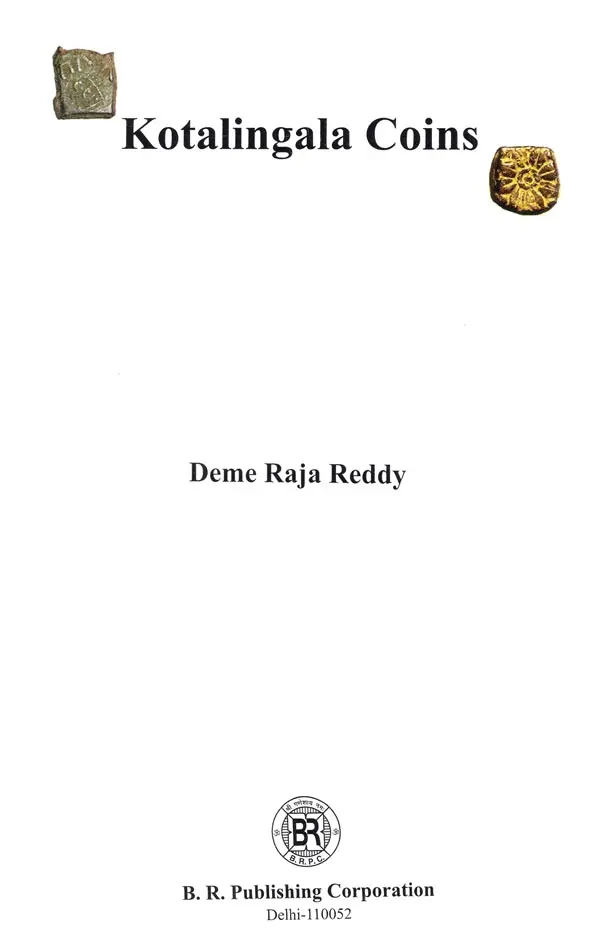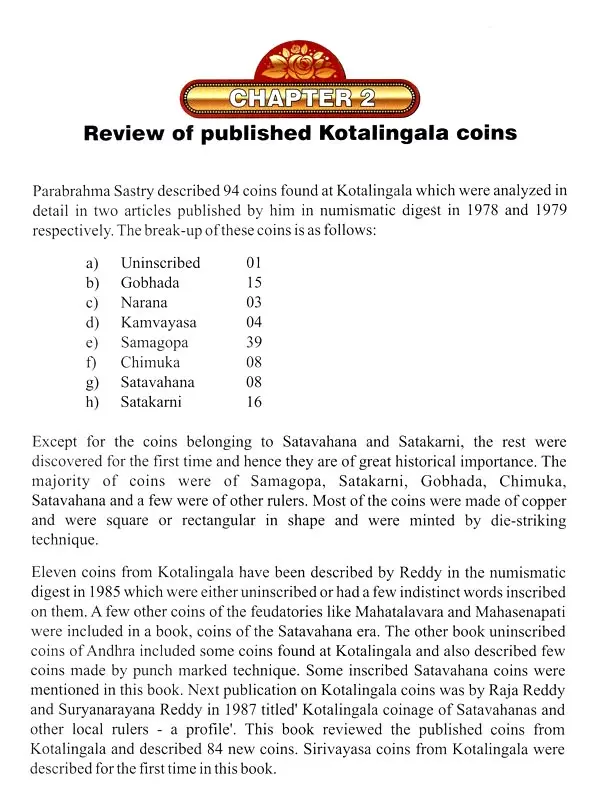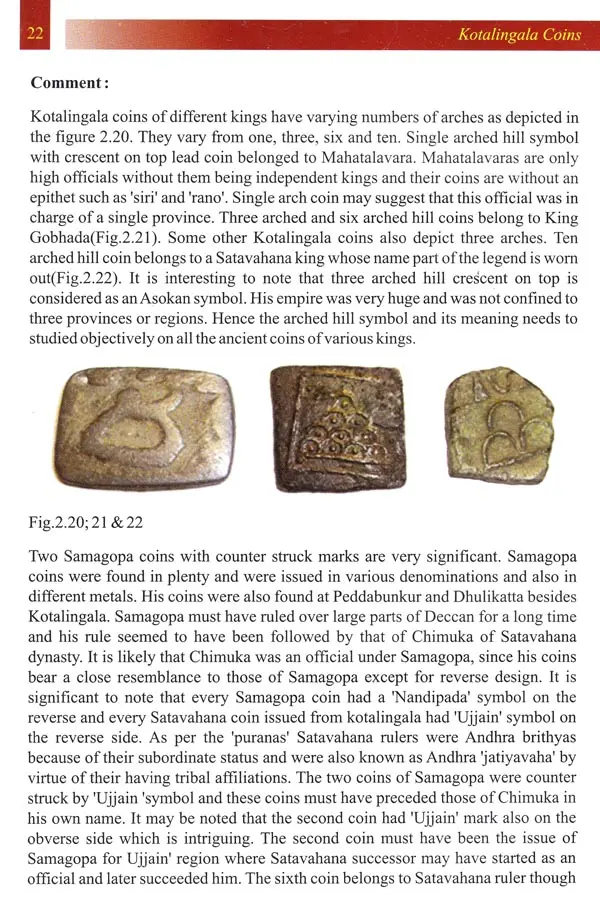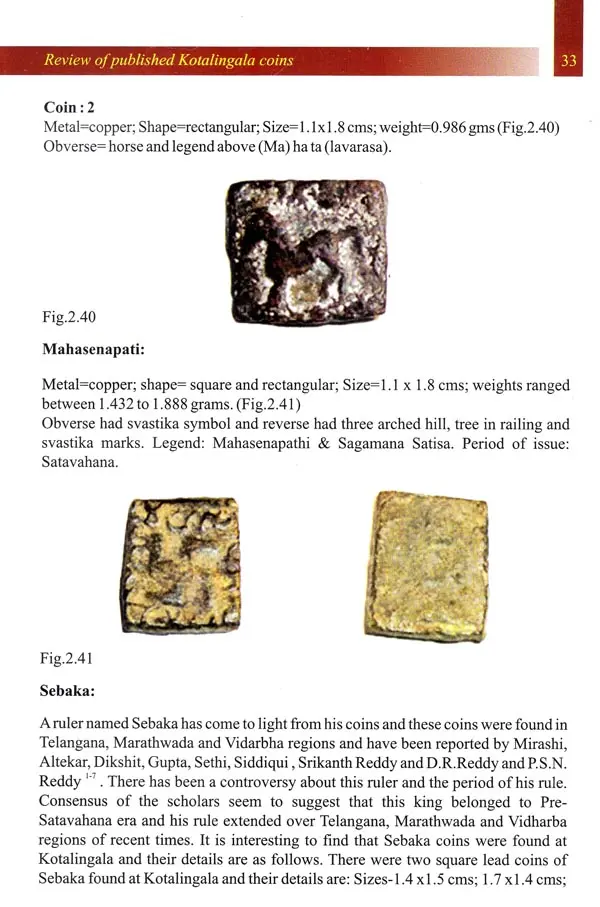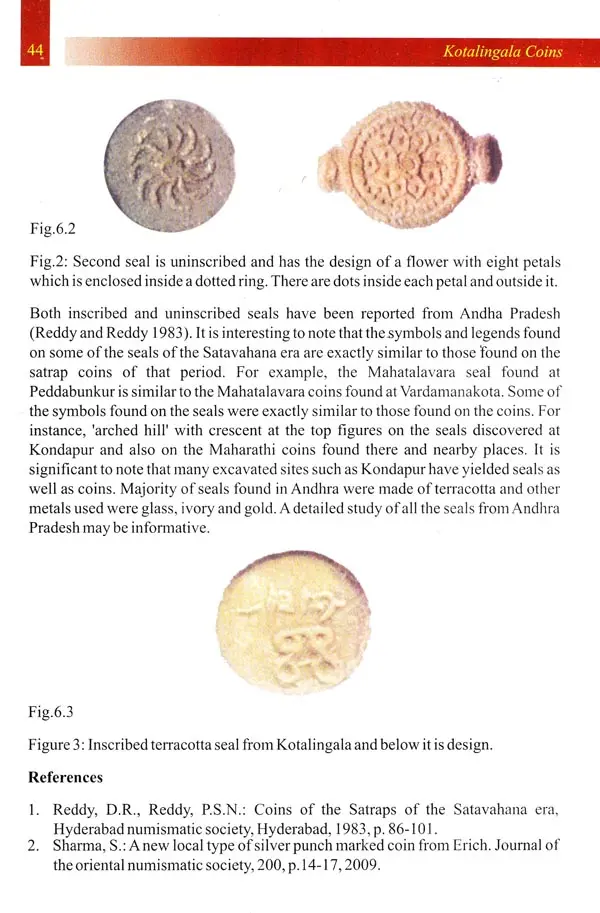
Kotalingala Coins
Book Specification
| Item Code: | UAM961 |
| Author: | Deme Raja Reddy |
| Publisher: | B.R. Publishing Corporation |
| Language: | English |
| Edition: | 2013 |
| ISBN: | 9789350500798 |
| Pages: | 78 (Color Illustrations) |
| Cover: | HARDCOVER |
| Other Details | 10.00 X 7.50 inch |
| Weight | 470 gm |
Book Description
The discovery of Kotalingala coins in 1978 is considered as a very significant event in Andhra numismatics. The coins found at Kotalingala brought to light the names of many unknown Pre-Satavahana kings. The coins of Chimuka, the founder of the illustrious dynasty of Satavahana were discovered for the first time at Kotalingala. The book describes the staggering variety of coins which surfaced at Kotalingala and their significance to early Andhra history".
Professor Deme Raja Reddy is a renowned neurosurgeon and numismatist. He has published many books on Andhra coins.
He has been the past president of the "South Indian numismatic society" and the editor of the 'Journal of studies in south Indian coins'. He has been the recipient of the Marremanda Rama Rao medal of the numismatic society of India.
The three major source materials available for the study of Satavahana history are the literary works, inscriptions and coins of that period". Considering the long duration of the Satavahana rule it may be said that the source materials of all the three types which are available are, indeed, meager. Literary works are of two types. Puranas and other written material of that period. Puranas which deal with the Satavahana period are the Vayu, Brahmanda, Vishnu, Bhagvata and Matsya which were written decades and even centuries after the events concerned had taken place. and hence many inaccuracies crept into them. It is true that most of the information culled from the Puranas about this dynasty has been collaborated by the inscriptions and coins but there are many conflicting facts. For instance, no two lists of Satavahana kings mentioned in these Puranas agree with each other as to their succession or their duration of rule. The names of the kings belonging to this dynasty vary in number from 19 to 29 or 30 and the duration of the rule calculated by adding the periods of rule of individual kings varies from 268 years in Vayu Purana to 435 years in Matsya Purana though they mention that the dynasty lasted for 456-460. years. Hala is listed as a member of Satavahana family by all the Puranas except. Brahmanda and Satakarni II is mentioned as the fourth king by the Vayu Purana, ast the fifth by the Vishnu and Brahmanda Puranas and as the sixth by the Matsya Purana but it is omitted by the Bhagvata Purana. Satasri, Rudra, Kara and Kumba are not mentioned in Puranas as the kings belonging to this family but their coins have been found which may mean that they must be either kings of the family or of a collateral branch. Similarly, coins and inscriptions of the middle group of kings listed in the Puranas have not been found. Thus it may be seen that the Puranas, though informatively helpful to some extent, are not very accurate to attempt a historical documentation of Satavahana history.
Among the literary works written during the Satavahana period, only a few are available and mention should be made of the following: a) Gatha Sapthasathi or Sattasai of Hala, B) Brihathatkatha of Gunadhya and its three Sanskrit versions, namely, the Kathasarithsagara of Somadeva, Brihathkatha Manjari of Kshemendra and Brihathkatha Sloka Sangraha of Buddha Swami, c) Katantra Vyakarna of Sarvaverman and d) the Mritchikatika of Sudraka. There are also other works of Hala and those of the poets of his court, namely Palita, Pothisa, Kouhala, Harviddha, Nandivriddha and Nagarjuna and Aryadeva who were also supposed to have lived during the Satavahana period. It is worth noting that there are references of Satavahana coinage in Sattasai'. There are also some later works which discuss the Satavahana times, namely, Yugapurana, Kavyamimamsa, Kama sutra. Sarasvati Kantabharana and Jaina Sutra writings. All these literary works help in gaining a glimpse of the social, religious and economic aspects of life of the people of those times but are not very helpful to historical documentation.
One of the most illustrious dynasties of India, the Satavahanas ruled over the Deccan after the Mauryas, Sungas and Kanvas. They left behind great works of art such as the famous Sanchi and Amaravati stupas and rock cut temples in western India. However, they have been the subjects of a lively controversy, which has not yet abated. Several questions been raised concerning them. Firstly, who were the Satavahanas? Were they really Andhras as represented by the puranas? However, nowhere in their records were the Satavahanas called Andhras. In fact, contemporary inscriptions like Hathigumpa referred to them as Satavahanas but not as Andhras. Secondly, when did their rule begin? Was it 230 BC or in the third quarter of the first century BC. However, there is agreement as to when their rule ended which was around 230 AD. Thirdly how long their rule lasted. Was it 456 to 460 years or for a much shorter period? Lastly, where did their rule begin? Was it coastal Andhra, Vidarbha, Western Maharashtra or in Telangana region. Kotalingala coins discovered in 1978 AD answered most of these queries.
Kotalingala coins may be said to have unrolled the scrolls of history of the Satavahanas ending the controversies raised by the testimony of the puranas, literary works and the inscriptions. These coins indeed, have been like spots of light illuminating the dark corners of history, bringing to view hitherto unknown rulers of the pre-Satavahana period, establishing the identity of the founder of the Satavahana dynasty and those succeeding him besides the changing face of their empire which in its splendor, power and extent rivaled the Mauryan and Kushan empires encompassing the northern India in the earlier times. This book on Kotalingala coins describes the site; details of the coins discovered there, their weights, metals used for making them and the significance of their find to the early Andhra history. A note on the contribution of coins to the Satavahana history follows.
The variety of coins found at Kotalingala is, indeed, staggering and affords a fascinating glimpse of the ancient Andhra history. It is not surprising that this find has come to be regarded as one of the important events in the Deccan numismatics. The coins unearthed are of punch-marked, uninscribed and inscribed varieties. The inscribed coins are those belonging to rulers such as Gobhada, Narana, Kamvayasa, Sirivayasa, Samagopa, Chimuka, Siri Satavahana, Satakarni I, Satisri, Satakarni II, Vasistiputra Pulumavi, Vasistiputra Satakarni and feudatories like Mahatalavara, Mahasenapati and Sebaka. No coins of post-Satavahana period were found at this site. Obviously, punch-marked and uninscribed date back to the Pre-Satavahana period whereas the inscribed coins excluding those of Satavahana rulers relate to Pre- Satavahana and post-Mauryan era. Inscribed Pre-Satavahana and Chimuka coins were discovered for the first time in the country. Kotalingala coins were described by Parabrahma Sastry. Raja Reddy and Suryanarayana Reddy and commented upon by Gupta, Bajpai" Sarma and Shastri. Some uninscribed and a few indistinctly inscribed coins have been described. Besides the coins enormous variety of beads, terracotta objects etc were found at the site.
Kotalingala is an ancient site and now is a small village situated between 18-52 N latitude and 79-12 longitude on the right bank of the river Godavari in Peddapalli taluk of Karimnagar district in Andhra Pradesh. Facing it on the north bank lies Luxettipet, a taluk head-quarter in the Adilabad district (Map.1.1). Here lies a confluence formed by the river Godavari and a rivulet, 'Peddavagu' which flows from Jagtial taluk in the south-north direction to merge into the river Godavari. Both these are perennial rivers and the selection of the site by early Telugu rulers is indeed significant. Kotalingala lies about 62 kilometers, north east from the district headquarters of Karimnagar on the Karimnagar- Nagpur highway. The village is also close to other places of archaeological interest in respect of Satavahana period, viz., Peddabunkur, Dhulikatta and also megalithic burial site in Kadambapur. Many other megalithic sites are located in Karimnagar region of Telangana.
